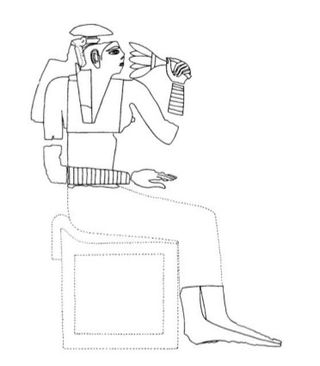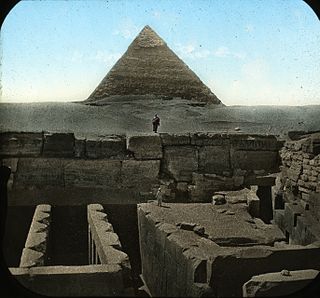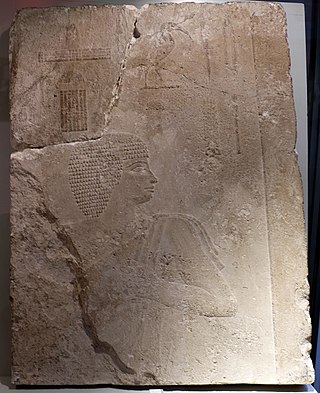| Tomb number | Type | Name of owner | Title owner | Time Period | Comments |
|---|
| G 7011 | Stone-Mastaba | Khnumwer | | | |
| G 7050 | Stone-Mastaba | Nefertkau I | King's daughter | Dynasty IV | Daughter of Sneferu. Mother of Nefermaat II and grandmother of Sneferukhaf. |
| G 7060 (LG 57) | Stone-Mastaba | Nefermaat II | King's Son and Vizier | Dynasty IV (Khafre) | Son of Nefertkau I. |
| G 7070 (LG 56) | Stone-Mastaba | Sneferukhaf | Treasurer of the King of Lower Egypt, Herdsman of Apis, etc. | Mid IV to Dynasty V | Son of Nefermaat II. |
| G 7101 | Stone-Mastaba | Merirenefer called Qar | Overseer of all works, he who is at the head of the king, true royal document scribe in the presence, etc. | Dynasty VI (Pepi I or later) | Son of Idu (G 7102) |
| G 7102 | Stone-Mastaba | Idu | Overseer of the great chapel, overseer of scribes of the meret-serfs, etc. | Dynasty VI (Pepi I or later) | Father of Qar ( G 7101) |
| G 7111 | Stone-Mastaba | | | Late IV to early Dynasty V | |
| G 7112 | Mud-brick mastaba | | | Dynasty V (reign of Nyuserre Ini) | |
| G 7121 | Stone-Mastaba | | | Dynasty IV? | Ushabti fragments inscribed for the High Priest of Ptah in Memphis, named Pahemnetjer, were found. |
| G 7133 | Stone-Mastaba | Minankh | Royal acquaintance | Late Dynasty IV | Khufukhaf I is mentioned in the tomb. |
| G 7142 | Mud-brick mastaba | | | V to Dynasty VI (?) | Names of Nabeni and Nebuka appear on lintel. |
| G 7145 +7147 | Double-Mastaba | | | | The mastaba had 7 burial shafts. |
| G 7148 +7149 | Double-Mastaba | | | | The mastaba had 5 burial shafts. |
| G 7150 | 
Stone-Mastaba | Khufukhaf II and his wife Khentkaues | Khentkaues is a King's daughter of his body | Dynasty V (time of Nyuserre Ini) | Possibly a son of Khufukhaf I. |
| G 7152 | Stone-Mastaba | Sekhemankhptah | | Late V or Dynasty VI | |
| G 7211 | Stone-Mastaba | | | | There are 16 burial shafts. Attested are Mereru and Ipty (on a lintel reused in roofing of shaft G 7214 B) and Inkaf (judge, inspector of scribes shaft G 7214 A). |
| G 7214 | Stone and brick Mastaba | Kaemankh | | Late Dynasty V or Dynasty VI | |
| G 7215 | Rock-cut tomb | Bendjet? | | Dynasty VI? | Bendjet is the daughter of Idu (G 7102) and likely the sister of Qar (G 7101). Nebit, wife of Qar is attested on a doorjamb. The names of Nebenheb, Nedjfu are inscribed on a headrests. Mentioned in inscriptions are Nefrethakhufu (named Sherit?) and Wabha. |
| G 7244 +7246 | Double-Mastaba | Khuenptah | | Dynasty V | Khuenptah's mother Intkaes and wife Khenut are mentioned. |
| G 7248 | Stone and rubble mastaba | Mestju ? | ka-priest | Dynasty V or Dynasty VI | Mestju may not be the actual owner. He is the owner of a false door which depicts him with his wife Nebuhetep and a daughter Khenut. |
| G 7249 | Stone and brick Mastaba | Menib | | IV or Dynasty V | |
| G 7331 +7332 | Double-Mastaba | | | | |
| G 7350 | Stone-Mastaba | Hetepheres II(?) | | End of Dynasty IV | Kawab, Djedefre and Hetepheres II are mentioned in inscriptions. |
| G 7391 | Stone-Mastaba | Iteti and his wife Senetankh | | Dynasty V | Mentioned in the tomb are Iteti's sons Washkakhafre, Iteti, and Werkaukhafre, and a daughter named Autib. Also shown are his brother Khafreankh and sister Rudj. |
| G 7411 | Stone-Mastaba | Kaemtjenent and his wife Hathornefer | | Dynasty V | |
| G 7413 | Rock-cut tomb, stone casing | Niankh-Khufu | | | |
| G 7432 | Stone-Mastaba | Qar | | Late Dynasty V | |
| G 7509 | Shafts only | Meresankh Isi | | | |
| G 7510 | Stone-Mastaba | Ankhhaf and wife Hetepheres | Ankhaf: King's Son and Vizier | Dynasty IV | Hetepheres was a daughter of Sneferu and Hetepheres I. |
| G 7511 | Stone-Mastaba | | | Ptolemaic Period | Shabtis inscribed for Djedhor and Isetreshet. |
| G 7512 | Mud-brick mastaba | Maakheru | | V – Dynasty VI | |
| G 7521 | Mud-brick mastaba | Nihetep-ptah Hepi | Inspector of palace attendants of the Great House | | Wife: Imty, sisters: Inty, Teti and Meresankh. Sons: Sesiheryib, Sesikhemetnu, Sesiwer. Daughters: Wehemre, Shefetnet, Henenti and Nebet. |
| G 7523 | Stone-Mastaba | Sedaf Iby | Overseer of the Two Houses, director of the broad hall | V – Dynasty VI | |
| G 7524 | Stone-Mastaba | Kay | Judge and administrator, preeminent of place, overseer of commissions | XXVI dynasty | |
| G 7530 +7540 | Stone-Mastaba | Meresankh III | King's daughter | Late Dynasty IV | Meresanch was a daughter of Kawab and wife of king Khafre. Graffiti with mention of years were found in the tomb. [5] : 119, Fig. 7 |
| G 7550 (LG 58) | Stone-Mastaba | Duaenhor | King's son | Dynasty IV | |
| G 7560 | Stone-Mastaba | | | Middle or late Dynasty IV | |
| G 7631 | Stone Mastaba | Ninefer | | V – Dynasty VI | |
| G 7632 | Stone-Mastaba | | | Late Period | People attested in the tomb are: Nesiptah, Tashamsha, Wahibre, Ahmose, Ankhenes-(?), Hetepef-hesu-(?), Psamtik-seneb, Wadjetirdis, Ankhtef, and Isiskhebit. |
| G 7650 | Stone-Mastaba | Akhethotep and his wife Meritites II | Akhethotep: director of the palace Meritites: King's daughter of his body | Dynasty IV | Meritites was a daughter of Khufu. |
| G 7660 (LG 59) | Stone-Mastaba | Kaemsekhem | King's Son | Late Dynasty IV | Son of Kawab. |
| G 7690 | Stone-Mastaba | Iui | Inspector of ka-priests | Old Kingdom | |
| G 7710 | Rock-cut tomb, Stone casing | Iby | Royal acquaintance, juridical scribe, secretary, etc. | V – Dynasty VI | |
| G 7711 | Rock-cut tomb | Khnumdjedef | King's son | V – Dynasty VI | |
| G 7721 | Rock-cut tomb | Kakherptah | | Dynasty V | |
| G 7750 | Stone-Mastaba | | | Mid to late Dynasty IV | Sons of the owner named Khenuka and Kamenekh are mentioned. |
| G 7757 | Stone-Mastaba | Kheperre | General (Overseer of the army) | Ptolemaic Period | His mother Tashereteniset was buried here as well. The sarcophagus is now in the Museum of Fine Arts in Boston. [6] |
| G 7760 (LG 60) | Stone-Mastaba | Mindjedef | King's Son | Dynasty IV | Mindjedef is a son of Kawab. |
| G 7772 | Stone-Mastaba | | | Dynasty V | |
| G 7788 | Stone-Mastaba | | | XVIII dynasty | |
| G 7792 | Stone-Mastaba | | | XXVI dynasty | Ushabtis were found with names: Wahibre, Denitptah, Denitenkhonsu, Tasheri-ihet, and Patjenef. A statue of Osiris is now in the Museum of Fine Arts in Boston. [7] |
| G 7803 | Rock-cut tomb | | | V – Dynasty VI | Graffiti mentioning dates were found in the tomb. [5] : 120, Fig. 7, 128 |
| G 7809 | Mud-brick, rubble mastaba | Reti | royal acquaintance, overseer of ka-priests | Dynasty V | |
| G 7810 | Stone-Mastaba | Djati | King's son | Late IV or early Dynasty V | |
| G 7814 | Rock-cut tomb | Kaaper | | V – Dynasty VI | |
| G 7815 | Rock-cut tomb | Hapennebti | | V – Dynasty VI | |
| G 7820 | Stone-Mastaba | Nefertkau III and her husband Iynefer | | Late IV or early Dynasty V | Nefertkau may be a daughter of Meresankh II. |
| G 7821 | Rock-cut tomb | Neferseshemptah Sheshi and his wife Meresankh | royal acquaintance, steward of the Great Estate | V – Dynasty VI | |
| G 7822 | Rock-cut tomb | Mesu and his wife Neferdjes | | V – Dynasty VI | |
| G 7836 | Rock-cut tomb | Nebtyherkaus | | Dynasty V | |
| G 7837 +7843 | Rock-cut tomb | Ankhmare | | First half of Dynasty V | Two separate mastabas were combined into one. [2] : 238–239 : 314 |
| G 7851 | Rock-cut tomb | Wermeru and his wife Isutkau | Royal wab-priest, priest of Heka, priest of Snefru, priest of Khafre | Late V – Dynasty VI | |
| G 7911 | Mud-brick mastaba | Nikhasutnisut | Scribe, ka-priest | V – Dynasty VI | |
| G 7946 | Mud-brick mastaba | Nefu and his wife Khenmetsetju | | V – Dynasty VI | |
| G 7948 (LG 75) | Rock-cut tomb | Khafreankh and his wife Nikahor | | Dynasty V or later | |

















